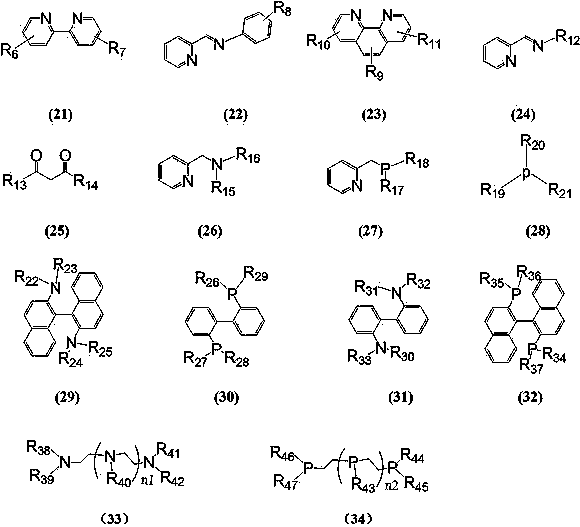Low-cost and environment-friendly synthesis method of biphenyl derivatives
A technology for green synthesis and derivatives, which is applied in the field of low-cost green synthesis of biphenyl derivatives, can solve problems such as low boiling point, unfavorable industrial production, and difficult recycling, so as to simplify the process operation steps, facilitate recycling and reuse, and realize the preparation cost Effect
- Summary
- Abstract
- Description
- Claims
- Application Information
AI Technical Summary
Problems solved by technology
Method used
Image
Examples
Embodiment 1
[0040] 4-Bromo-o-xylene (36.6 g, 0.2 moL), zinc powder (13 g, 0.2 moL), anhydrous cyclopentyl methyl ether (60 g, 0.6 moL), anhydrous NiCl 2 (0.51 g, 4 mmoL) and triphenylphosphine (2 g, 8 mmoL), mixed in a nitrogen atmosphere, 85 o After C reacted for 8 hours, cool down, filter off the inorganic matter, and the filtrate recovered 49 g of 2-methyltetrahydrofuran solvent through distillation, and collected 145 ~ 155 g by distillation under reduced pressure. o Fraction C (pressure 1~3 mmHg), obtained 19.1 g of 3, 3’, 4, 4’-tetramethylbiphenyl, yield 90%, melting point 74~75 o c.
Embodiment 2
[0042] 3-Chloro-o-xylene (28 g, 0.2 moL), manganese (1.1 g, 0.2 moL), anhydrous cyclopentyl methyl ether (50 g, 0.5 moL), anhydrous NiCl 2 (0.51 g, 4 mmoL), bipyridine (1.25 g, 8 mmoL) were mixed in a nitrogen atmosphere, 80 o C reacted for 8 hours, cooled, filtered off inorganic matter, and the filtrate recovered 40 g of 2-methyltetrahydrofuran solvent through distillation, and collected 135 to 145 by distillation under reduced pressure. o Fraction C (pressure 1~3 mmHg), obtained 17.9 g of 2, 2’, 3, 3’-tetramethylbiphenyl with a yield of 85% and a melting point of 115~116 o c.
Embodiment 3
[0044] Dimethyl 4-chlorophthalate (22.8 g, 0.1 moL), zinc powder (6.5 g, 0.1 moL), anhydrous cyclopentyl methyl ether (50 g, 0.5 moL), anhydrous NiBr 2 (0.65 g, 3 mmoL), triphenylphosphine (2.6 g, 10 mmoL), 75 o C reaction for 10 hours, then cooled and filtered to remove inorganic matter, and the filtrate was distilled to recover 46 g of 2,5-dimethyltetrahydrofuran solvent, and the obtained crude product of tetramethyl biphenyl tetracarboxylate was recrystallized from methanol to obtain 17 g of pure product, with a yield of 88 %;. Add the obtained tetramethyl biphenyl tetracarboxylate into a mixture of 100 mL of water and 10 mL of sulfuric acid, heat to reflux for 24 hours, cool and filter, collect the precipitate, and o The C program divided the temperature into three stages and raised the temperature for 15 hours to obtain 12.5 g of 3, 3', 4, 4'-biphenyltetracarboxylic dianhydride, with a yield of 96%.
PUM
 Login to View More
Login to View More Abstract
Description
Claims
Application Information
 Login to View More
Login to View More - R&D
- Intellectual Property
- Life Sciences
- Materials
- Tech Scout
- Unparalleled Data Quality
- Higher Quality Content
- 60% Fewer Hallucinations
Browse by: Latest US Patents, China's latest patents, Technical Efficacy Thesaurus, Application Domain, Technology Topic, Popular Technical Reports.
© 2025 PatSnap. All rights reserved.Legal|Privacy policy|Modern Slavery Act Transparency Statement|Sitemap|About US| Contact US: help@patsnap.com



